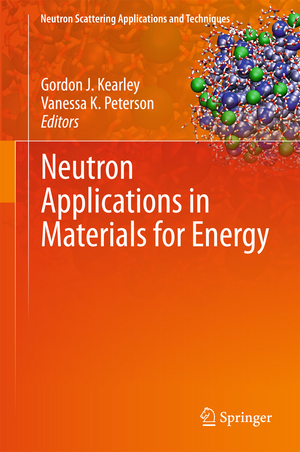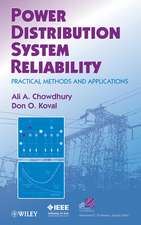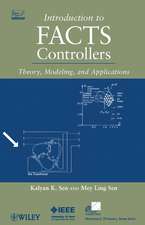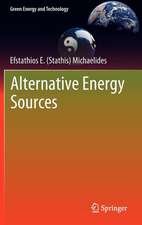Neutron Applications in Materials for Energy: Neutron Scattering Applications and Techniques
Editat de Gordon J. Kearley, Vanessa K. Petersonen Limba Engleză Hardback – 5 feb 2015
Whilst neutron scattering is extensively used to understand properties of condensed matter, neutron techniques are exceptionally-well suited to studying how the transport and binding of energy and charge-carrying molecules and ions are related to their dynamics and the material’s crystal structure. These studies extend to in situ and in operando in some cases. The species of interest in leading energy-technologies include H2, H+, and Li+ which have particularly favourable neutron-scattering properties that render these techniques of analysis ideal for such studies and consequently, neutron-based analysis is common-place for hydrogen storage, fuel-cell, catalysis, and battery materials. Similar research into the functionality of solar cell, nuclear, and CO2 capture/storage materials rely on other unique aspects of neutron scattering and again show how structure and dynamics provide an understanding of the material stability and the binding and mobility of species of interest within these materials.
Scientists and students looking for methods to help them understand the atomic-level mechanisms and behaviour underpinning the performance characteristics of energy materials will find Neutron Applications in Materials for Energy a valuable resource,whilst the wider audience of sustainable energy scientists, and newcomers to neutron scattering should find this a useful reference.
Preț: 645.79 lei
Preț vechi: 759.76 lei
-15% Nou
Puncte Express: 969
Preț estimativ în valută:
123.58€ • 129.61$ • 102.87£
123.58€ • 129.61$ • 102.87£
Carte tipărită la comandă
Livrare economică 01-15 aprilie
Preluare comenzi: 021 569.72.76
Specificații
ISBN-13: 9783319066554
ISBN-10: 3319066552
Pagini: 306
Ilustrații: X, 306 p. 166 illus., 81 illus. in color.
Dimensiuni: 155 x 235 x 20 mm
Greutate: 0.57 kg
Ediția:2015
Editura: Springer International Publishing
Colecția Springer
Seria Neutron Scattering Applications and Techniques
Locul publicării:Cham, Switzerland
ISBN-10: 3319066552
Pagini: 306
Ilustrații: X, 306 p. 166 illus., 81 illus. in color.
Dimensiuni: 155 x 235 x 20 mm
Greutate: 0.57 kg
Ediția:2015
Editura: Springer International Publishing
Colecția Springer
Seria Neutron Scattering Applications and Techniques
Locul publicării:Cham, Switzerland
Public țintă
GraduateCuprins
Preface.- Glossary.- 1 Neutron Applications in Energy Materials Research.- Part I Energy Generation.- 2 Catalysis.- 3 CO2 Separation, Capture, and Storage in Porous Materials.- 4 Materials for the Nuclear Energy Sector.- 5 Solar Cells: Chalcopyrite Thin Film Devices.- 6 Solar Cells: Organic Devices.- Part II Energy Storage.- 7 Li-ion Batteries.- 8 Hydrogen Storage Materials.- Part III Energy Use.- 9 Fuel Cells: Neutron Scattering of Proton-Conducting Ceramics.- 10 Fuel Cells: Neutron Techniques as a Probe of Structure, Dynamics and Transport in Polyelectrolyte Membranes.
Recenzii
“Gordon J. Kearley and Vanessa K. Patterson have edited a remarkable and long due book in the Springer series Neutron Scattering Applications and Techniques. In the newest issue on the topic of energy materials contributions from some of the leading neutron scatterers in this field have been gathered. … this book demonstrates the power of neutron scattering and imaging for energy research and thus represents an important tool to bridge the gap between neutron scattering specialists and energy researchers.” (Joel Mesot, Neutron News, Vol. 26 (4), 2015)
Notă biografică
Prof Don Kearley received his PhD from the University of East Anglia, UK, worked at the Institut Laue-Langevin in Grenoble, France, became Chair of Radiation Physics at Delft University of Technology, the Netherlands, and is presently Senior Researcher in the Neutron Scattering Group at the Bragg Institute of ANSTO (Australian Nuclear Science and Technology Organization). He has a fair experience of most neutron-scattering techniques, particularly inelastic and quasielastic methods. Currently most of his work is in providing modelling support for the neutron scattering activities of scientists at the Bragg institute and elsewhere, which is usually in the form of understanding the underlying mechanism in function. Dr Vanessa Peterson is a Senior Research and Instrument Scientist at ANSTO (Australian Nuclear Science and Technology Organization). Her expertise includes structure and dynamics in chemistry and their relationship to properties in condensed matter materials including cement,porous coordination framework materials, and hydrogen storage materials. She has also great expertise in analyses techniques like Synchrotron/Laboratory X-Ray and Neutron Powder Diffraction, Rietveld analysis, Quasi-Elastic Neutron Scattering, Inelastic Neutron Scattering, and Single Crystal X-Ray Diffraction.
Textul de pe ultima copertă
This book collects the results and conclusions of recent neutron-based investigations of materials that are important in the development of sustainable energy. The individual chapters were written by leading scientists with hands-on experience in the field, providing overviews, recent highlights, and case studies to illustrate the applicability of one or more neutron-based analytical techniques. Though the main focus is on energy production, storage, and use, each chapter and section can also be read independently, with basic theory and instrumentation for neutron scattering being outlined in the introductory chapter.
While neutron scattering is extensively used to understand the properties of condensed matter, neutron techniques are exceptionally-well suited to studying how the transport and binding of energy and charge-carrying molecules and ions are related to their dynamics and the material’s crystal structure. In some cases, these studies extend to in situ andin operando. The species of interest in leading energy-technologies include H2, H+, and Li+, as their particularly favorable neutron-scattering properties make them ideal for such studies; as a result, neutron-based analysis is commonplace for hydrogen storage, fuel-cell, catalytic, and battery materials. Similar research into the functionality of solar-cell, nuclear, and CO2 capture/storage materials rely on other unique aspects of neutron scattering and again show how their structure and dynamics provide an understanding of the material stability and the binding and mobility of species of interest.
Scientists and students looking for methods to help them understand the atomic-level mechanisms and behavior underpinning the performance characteristics of energy materials will find Neutron Applications in Materials for Energy a valuable resource, while the broader audience of sustainable energy scientists and newcomers to neutron scattering should find this a valuable reference work.
While neutron scattering is extensively used to understand the properties of condensed matter, neutron techniques are exceptionally-well suited to studying how the transport and binding of energy and charge-carrying molecules and ions are related to their dynamics and the material’s crystal structure. In some cases, these studies extend to in situ andin operando. The species of interest in leading energy-technologies include H2, H+, and Li+, as their particularly favorable neutron-scattering properties make them ideal for such studies; as a result, neutron-based analysis is commonplace for hydrogen storage, fuel-cell, catalytic, and battery materials. Similar research into the functionality of solar-cell, nuclear, and CO2 capture/storage materials rely on other unique aspects of neutron scattering and again show how their structure and dynamics provide an understanding of the material stability and the binding and mobility of species of interest.
Scientists and students looking for methods to help them understand the atomic-level mechanisms and behavior underpinning the performance characteristics of energy materials will find Neutron Applications in Materials for Energy a valuable resource, while the broader audience of sustainable energy scientists and newcomers to neutron scattering should find this a valuable reference work.
Caracteristici
First book focused on neutron scattering for sustainable energy materials Offers contributions by top specialists in the field Discusses the future prospects of neutron scattering techniques for sustainable energy materials Includes supplementary material: sn.pub/extras





























